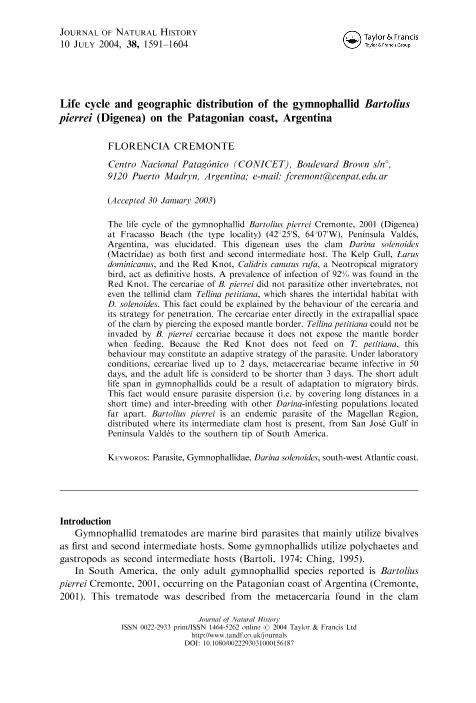Mostrar el registro sencillo del ítem
dc.contributor.author
Cremonte, Florencia

dc.date.available
2017-11-10T20:31:45Z
dc.date.issued
2004-07-10
dc.identifier.citation
Cremonte, Florencia; Life cycle and geographic distribution of the gymnophallid Bartolius pierrei (Digenea) on the Patagonian coast, Argentina; Taylor & Francis; Journal of Natural History; 38; 13; 10-7-2004; 1591-1604
dc.identifier.issn
0022-2933
dc.identifier.uri
http://hdl.handle.net/11336/27964
dc.description.abstract
The life cycle of the gymnophallid Bartolius pierrei Cremonte, 2001 (Digenea) at Fracasso Beach (the type locality) (42º25’S, 64º07’W), Península Valdés, Argentina, was elucidated. This digenean uses the clam Darina solenoides (Mactridae) as both first and second intermediate host. The Kelp Gull, Larus dominicanus, and the Red Knot, Calidris canutus rufa, a Neotropical migratory bird, act as definitive hosts. A prevalence of infection of 92% was found in the Red Knot. The cercariae of B. pierrei did not parasitize other invertebrates, not even the tellinid clam Tellina petitiana, which shares the intertidal habitat with D. solenoides. This fact could be explained by the behaviour of the cercaria and its strategy for penetration. The cercariae enter directly in the extrapallial space of the clam by piercing the exposed mantle border. Tellina petitiana could not be invaded by B. pierrei cercariae because it does not expose the mantle border when feeding. Because the Red Knot does not feed on T. petitiana, this behaviour may constitute an adaptive strategy of the parasite. Under laboratory conditions, cercariae lived up to 2 days, metacercariae became infective in 50 days, and the adult life is considerd to be shorter than 3 days. The short adult life span in gymnophallids could be a result of adaptation to migratory birds. This fact would ensure parasite dispersion (i.e. by covering long distances in a short time) and inter-breeding with other Darina-infesting populations located far apart. Bartolius pierrei is an endemic parasite of the Magellan Region, distributed where its intermediate clam host is present, from San José Gulf in Península Valdés to the southern tip of South America.
dc.format
application/pdf
dc.language.iso
eng
dc.publisher
Taylor & Francis

dc.rights
info:eu-repo/semantics/openAccess
dc.rights.uri
https://creativecommons.org/licenses/by-nc-sa/2.5/ar/
dc.subject
Ciclos de Vida
dc.subject
Aves Marinas
dc.subject
Distribución Geográfica
dc.subject
Parasite
dc.subject
Gymnophallidae
dc.subject
Darina Solenoides
dc.subject
South-West Atlantic Coast
dc.subject.classification
Otras Ciencias Biológicas

dc.subject.classification
Ciencias Biológicas

dc.subject.classification
CIENCIAS NATURALES Y EXACTAS

dc.title
Life cycle and geographic distribution of the gymnophallid Bartolius pierrei (Digenea) on the Patagonian coast, Argentina
dc.type
info:eu-repo/semantics/article
dc.type
info:ar-repo/semantics/artículo
dc.type
info:eu-repo/semantics/publishedVersion
dc.date.updated
2017-11-03T20:03:11Z
dc.identifier.eissn
1464-5262
dc.journal.volume
38
dc.journal.number
13
dc.journal.pagination
1591-1604
dc.journal.pais
Reino Unido

dc.journal.ciudad
Londres
dc.description.fil
Fil: Cremonte, Florencia. Consejo Nacional de Investigaciones Científicas y Técnicas. Centro Científico Tecnológico Conicet - Centro Nacional Patagónico; Argentina
dc.journal.title
Journal of Natural History

dc.relation.alternativeid
info:eu-repo/semantics/altIdentifier/doi/http://dx.doi.org/10.1080/0022293031000156187
dc.relation.alternativeid
info:eu-repo/semantics/altIdentifier/url/http://www.tandfonline.com/doi/abs/10.1080/0022293031000156187
Archivos asociados
